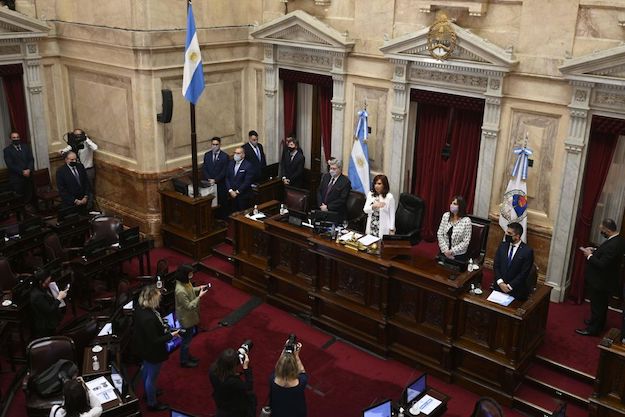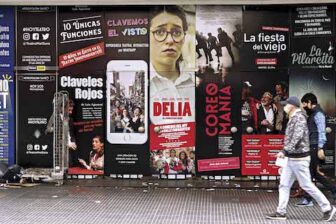BUENOS AIRES – Sir Isaac Newton’s law of motion holds that an object will continue moving in the same direction, and with the same velocity, unless it is affected by an external force. Unfortunately, this is clearly true of Argentina’s economy as we begin 2021.
Argentina’s inertia on its present course is strong. Its recent economic cycles have become so tightly spaced that we don’t get to see a sustained rebound before the next relapse occurs. The latest sequence could be described as a currency crisis that started at the end of 2017 and has been fluctuating on a clear downward trajectory ever since.
A conservative prognosis would suggest that, unless we see disruptive policies to change this inertia, then for the foreseeable future the country will continue to exhibit lagging exports, minimal investment, defensive ad hoc interventions, high inflation (currently at about 35% and climbing), persistent exchange rate pressure, slightly negative per capita growth (following a modest rebound from the pandemic), new or higher taxes to make up for a diminishing tax base, and a renewed flight of capital and people.
In sum, more of the same.
The challenge then is to consider Newton’s second law: Are there external forces big enough to substantially alter the inertia, and begin a new (better) course? Argentina is an over-diagnosed and under-executed country: There is actually considerable consensus right now about what is needed to jump-start the economy. In this article, I discuss some of the proposals, all of which have been fleshed out in more detail elsewhere, some even have bills waiting in Congress. But it would be misleading to place too much emphasis on technicalities: Since the beginning, Argentina’s crisis has been political. The way out, if it exists, must be as well.
Becoming Argentina
There has been much discussion in Argentina about the fear of becoming “another Venezuela.” This is misguided in my view. Instead, the country has been slowly edging from its middle-income trap towards a new, self-reinforcing, equilibrium: one that is entirely Argentine. Let me elaborate.
I have written previously in AQ about our two major macroeconomic handicaps: insufficient exports and a feeble currency. Let’s just add that, with no peso savings, Argentina funds its chronic fiscal imbalances with a mix of inflation and financial repression (exchange rate controls and negative real rates), punishing the very peso holders and investors that it so badly needs. Moreover, the country tends to shortsightedly support anti-trade coalitions with the illusion of maximizing and redistributing someone else’s rents (since the 60s, the farmers’; in the 70s, when the former proved insufficient, also those of local and foreign savers). These two handicaps feed off each other, fueling sovereign risk, inflation, dollarization and financial crises – and, more recently, the flight of companies and high-skilled jobs.
In addition, Argentina has been moving toward a path of “inclusive poverty”: Those socially excluded by the failure of the welfare state to provide public goods and upward mobility are “compensated” ex post with a monetary transfer funded by indirect taxes on labor and production that feeds back into the country’s stagnation and social exclusion. By end-2019, only 20% of the working-age population was employed in the private sector and contributing to the universal social security system –a ratio that will further deteriorate once the current ban on layoffs is lifted. Without a serious labor inclusion effort, no fiscal program or IMF-led package can make sustainable this “20/80 economy.”
A third ingredient is more recent and, possibly, more critical: Policy temporariness. Importantly, it is not economic, but political.
To cite some examples: Argentina’s government lowered wealth taxes in 2016 to pave the way for a successful tax amnesty, only to then raise them twice in the past 12 months. It cut labor taxes in 2017 to encourage formal employment in the context of a doomed tax reform. It sanctioned a Knowledge Economy Law in 2018 to promote high-skilled services – perhaps the country’s main untapped source of exports – only to rewrite it two years later. It lowered export taxes at the beginning of 2016 and then brought them back – to an even broader set of exports! – in 2019. It created an independent Anti-Trust Authority and, months later, placed it under the tutelage of the industrial sector. (There is more.)
If policy is transient and reversible, it loses its guiding effect, which is its main impact. If tomorrow the government offers targeted wage tax exemptions for the creation of new jobs, or grants exchange freedom to those who sink money into construction (as it insinuated a month ago), or partially lifts exports taxes (as it has just announced), then employers, investors and exporters will simply do nothing. “Wait and see” is the natural reaction to the temporary policy game. Indeed, this policy temporariness can work in perverse ways, inverting its intended impact: Lift exchange rate controls and everybody will rush to buy dollars (lest the government repents); relax the ban on layoffs and firms will use the time window to expedite payroll adjustments.
What to do?
So, what to do, then?
A stabilization plan may not be enough, but it is surely necessary. Such a plan should include a pension reform (already sanctioned as part of the 2016 Reparation Law but left for dead by wary politicians). In practice, this comprises three reforms, one for each of the three components of the system, which should be treated separately: The contributory one (which should be made consistent with underlying demographics), the universal one (which should be treated as any other social transfer within the Treasury’s budget) and the special regimes (which should be fully funded or phased out). A new fiscal pact is also needed to avoid tax arbitration and limit national and subnational indebtedness, as is a tax reform based on a progressive income tax schedule – eliminating exceptions, including a new high-income bracket (today capped at 35%), and reducing the nearly 170 current national and subnational taxes (which are highly distorting, often duplicated and administratively intractable).
A five-part labor inclusion program is inevitable to get out of the inclusive poverty trap. This should, at the very least, comprise an education reform to improve access to work, including the creation of a Vocational Training Agency and Labor Skills Council to guide it, and widely available work practices at the secondary and tertiary school levels. More importantly, it entails a deep cultural change in a country where education has lost its social mobility rationale. An emergency labor regime based on portable benefits is essential to repair access to employment for those displaced by the pandemic. Modern labor agreements should be versatile enough to provide general guidelines that could be adapted to the different cost structures and labor practices across regions, firm sizes, and activities. A regime for independent workers, the elephants in the room of the labor debate, should make them contributing taxpayers while reducing their precariousness and income instability. Last but not least, a minimum income floor set at the level of the indigence line (close to $90 per adult per month at the official exchange rate), directly transferred to a free universal bank account to eliminate intermediaries, could not only eliminate extreme poverty but, by conditioning it to training and job placement, would go a long way to reduce labor segregation and structural indigence.
It’s the politics
There are, of course, other policies (universal digital connectivity is essential to improve education and labor and to compete in global services; immigration policies are key to offset increasingly worrying demographics). But these core policies core should be enough to illustrate the initial point of this piece: Knowing what to do is not enough. It is a mistake to think that Argentina’s economic problems are economic in nature. International financial institutions and multilateral treaties may help sustain a long-term commitment, but none of these pending assignments seems viable if they are not processed politically.
Our tribal polarization (in the local jargon, grieta or fracture) has a paralyzing effect when combined with the policy temporariness mentioned above. To undo the trap a country needs, at least, a commitment to immunize core policies from the political cycle. Political polarization makes this minimal arrangement even less plausible and convincing.
The pieces for an understanding are on the table. If an agreement is not reached, even reformists will find it hard to implement credible reforms. Without these reforms, in ten years Argentina will be in worse shape than at the end of 2019 (let’s skip the unprecedented 2020), as in 2019 it was in worse shape than ten years previous. Without disruptions, there is no basis for the country’s inertia to change. That’s pure mechanics.
__
Levy Yeyati, an economist, is the dean of the School of Government of Universidad Torcuato Di Tella and a nonresident senior fellow at The Brookings Institution.








